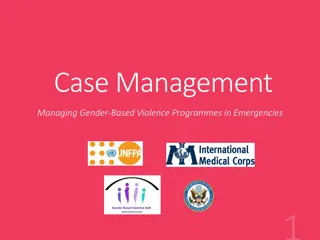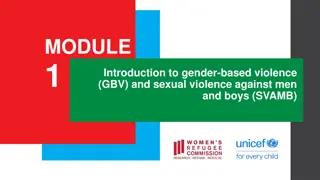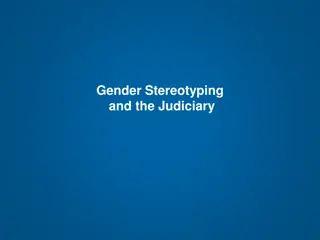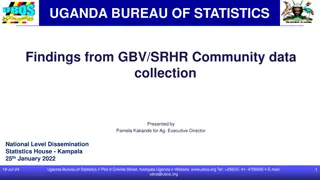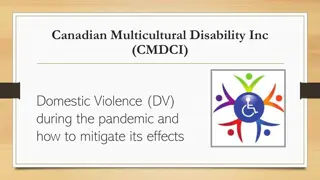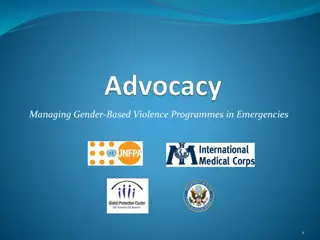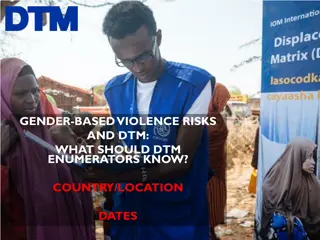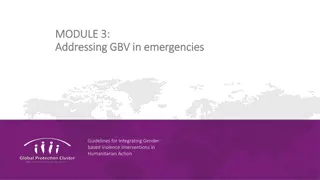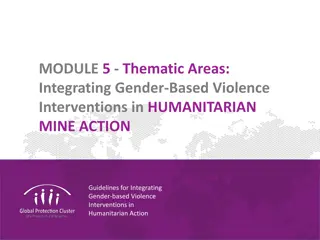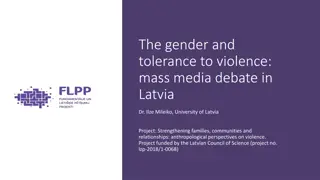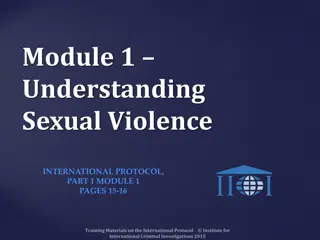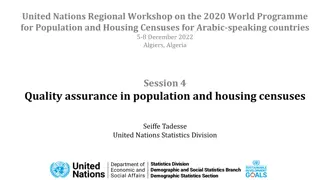Managing Gender-Based Violence Programmes in Emergencies
Identify responsibilities and strategies for GBV programmes in health emergencies. Learn about health sector actors, core elements of health response, resources, and working with the health sector to improve services and reduce barriers to care.
Download Presentation

Please find below an Image/Link to download the presentation.
The content on the website is provided AS IS for your information and personal use only. It may not be sold, licensed, or shared on other websites without obtaining consent from the author.If you encounter any issues during the download, it is possible that the publisher has removed the file from their server.
You are allowed to download the files provided on this website for personal or commercial use, subject to the condition that they are used lawfully. All files are the property of their respective owners.
The content on the website is provided AS IS for your information and personal use only. It may not be sold, licensed, or shared on other websites without obtaining consent from the author.
E N D
Presentation Transcript
1 GBV & Health Managing Gender-Based Violence Programmes in Emergencies
Objectives 1. Identify responsibilities of health actors related to GBV 2. Identify strategies and approaches for GBV programmes to influence health response to GBV
Pop Quiz 1. Name at least 4 actors who could be included within the health sector 2. List three core elements of a health response to GBV 3. Identify one tool or technical resource for supporting improved health response 4. True or False: The role of a healthcare worker is to establish whether a rape has occurred to support an effective legal response.
Health Sector Actors Facility-based health care workers: physicians nurses midwives allied health professionals (social workers, psychologists) Community-based health care workers: community health workers traditional birth attendants traditional healers Health and SRH coordinators, programme managers Ministry of Health representatives
Basic Elements of Health Response 1. Clinical/physical care (CMRIPV, abortion) 2. First Line Support (LIVES) 3. Referral for additional services Collecting evidence to support a criminal investigation
Resources Updated WHO Protocols and Training Health response to rape and Intimate Partner Violence More emphasis on referral, PSS and safety
Working with the Health Sector Purpose: 1. Improve quality of services 2. Increase awareness of services 3. Reduce barriers to seeking health care
Working with the Health Sector: 1. Improve Quality of Services Promote compassionate, survivor-centred care Provide basic GBV training for all health staff Specialized training for qualified providers for appropriate clinical care after SV and IPV Basic training to improve all staff interactions with and attitudes towards survivors Strengthen intake and consent procedures Ensure privacy, confidentiality, and safety
Working with the Health Sector: 2. Increase Awareness of Services Identify health services available in the community. Consider: Are drugs and devices for clinical management of rape available? Who are the trained providers? What other health services are available that might benefit survivors? Establish referral mechanisms to health services and trained providers. Share information on the availability and benefit of health services.
Effective Referral Mechanisms Referral pathway established, including clear points of contact, possible locations for service provision, and modes of transport established between health and: GBV case management and PSS support services Higher levels of medical care, as required Other services Mechanisms for sharing information for referrals established and aligned with guiding principles.
Working with the Health Sector: 3. Reduce Barriers Identify gaps in health prevention and response Assess community needs for health response Identify and address barriers to seeking/accessing health care Address barriers to seeking health care
Small Group Work BACKGROUND You are a GBV Programme Manager interested in addressing barriers that survivors face in accessing healthcare. An assessment of the community revealed critical access issues that you will address in your programme.
Small Group Work INSTRUCTIONS Each group will consider one (1) access issue. Identify an intervention, considering core approaches survivor-centred, intersectional, rights-based, community development Each group will report back in plenary: The barrier The intervention Considerations
Small Group Work BARRIERS 1. Only one clinic serves multiple communities with few transportation options. 2. Survivors must report to the police before accessing post-rape care. 3. All medical staff at the clinic are male. 4. All survivors of rape are referred to the sexual violence clinic in the capital (6 hours away by bus); no services are available locally. 5. The clinic completes detailed intake forms for all patients, including survivors of rape. Recently, the Ministry of Health has mandated that all intake forms be sent to the Ministry of Gender.
WHO video https://www.youtube.com/watch?v=Qc_GHITv TmI
Key Actions: GBV & Health Preposition supplies, including PEP and EC. Assess health facility readiness for survivor- centered care. Coordinate to build capacity of healthcare providers in CMR/IPV Train healthcare actors, including medical and non-medical staff, on GBV core concepts, including survivor-centred response.
Key Actions: GBV & Health Establish and maintain safe referral systems between health and other services and between different levels of health care. Appoint GBV focal point for health sector meetings and include health sector focal point in GBV meetings. Work with communities to address barriers to health access, including transportation options.
Key Actions: GBV & Health Engage community health workers, traditional birth attendants and other community-based health actors as entry points for referrals and basic support. Inform communities about the benefits and availability of timely post-rape care. Engage communities on the health consequences of IPV, EFM, and other forms of GBV.



